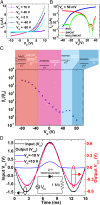Gate-tunable carbon nanotube-MoS2 heterojunction p-n diode
- PMID: 24145425
- PMCID: PMC3831469
- DOI: 10.1073/pnas.1317226110
Gate-tunable carbon nanotube-MoS2 heterojunction p-n diode
Abstract
The p-n junction diode and field-effect transistor are the two most ubiquitous building blocks of modern electronics and optoelectronics. In recent years, the emergence of reduced dimensionality materials has suggested that these components can be scaled down to atomic thicknesses. Although high-performance field-effect devices have been achieved from monolayered materials and their heterostructures, a p-n heterojunction diode derived from ultrathin materials is notably absent and constrains the fabrication of complex electronic and optoelectronic circuits. Here we demonstrate a gate-tunable p-n heterojunction diode using semiconducting single-walled carbon nanotubes (SWCNTs) and single-layer molybdenum disulfide as p-type and n-type semiconductors, respectively. The vertical stacking of these two direct band gap semiconductors forms a heterojunction with electrical characteristics that can be tuned with an applied gate bias to achieve a wide range of charge transport behavior ranging from insulating to rectifying with forward-to-reverse bias current ratios exceeding 10(4). This heterojunction diode also responds strongly to optical irradiation with an external quantum efficiency of 25% and fast photoresponse <15 μs. Because SWCNTs have a diverse range of electrical properties as a function of chirality and an increasing number of atomically thin 2D nanomaterials are being isolated, the gate-tunable p-n heterojunction concept presented here should be widely generalizable to realize diverse ultrathin, high-performance electronics and optoelectronics.
Keywords: 2D transition metal dichalcogenide; photodetector; rectifier; single layer MoS2; van der Waals heterostructure.
Conflict of interest statement
The authors declare no conflict of interest.
Figures




References
-
- Schwierz F. Graphene transistors. Nat Nanotechnol. 2010;5(7):487–496. - PubMed
-
- Jariwala D, Sangwan VK, Lauhon LJ, Marks TJ, Hersam MC. Carbon nanomaterials for electronics, optoelectronics, photovoltaics, and sensing. Chem Soc Rev. 2013;42(7):2824–2860. - PubMed
-
- Banerjee SK, et al. Graphene for CMOS and beyond CMOS applications. Proc IEEE. 2010;98(12):2032–2046.
-
- Britnell L, et al. Field-effect tunneling transistor based on vertical graphene heterostructures. Science. 2012;335(6071):947–950. - PubMed
-
- Georgiou T, et al. Vertical field-effect transistor based on graphene-WS2 heterostructures for flexible and transparent electronics. Nat Nanotechnol. 2013;8(2):100–103. - PubMed
Publication types
MeSH terms
Substances
LinkOut - more resources
Full Text Sources
Other Literature Sources
Miscellaneous

